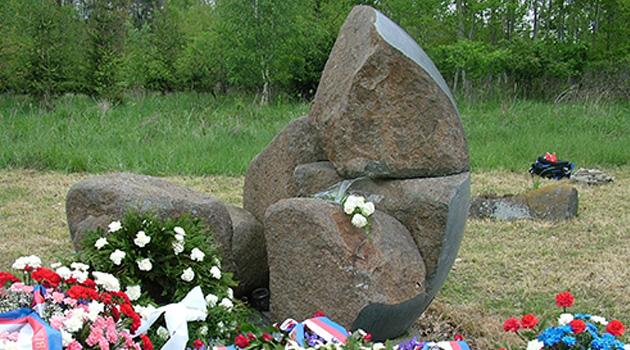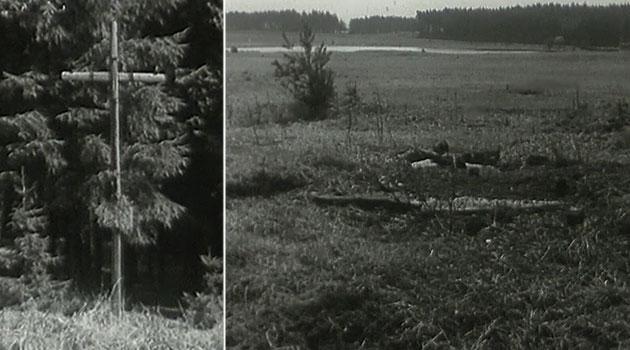Lety after the Romani genocide, Part Three: The 1990s pave the way to a price tag of half a billion crowns

This is the third installment in our series of articles (see parts one and two) dedicated to the postwar history of the former so-called “Gypsy Camp” at Lety u Písku, or rather, the history of its locations and surroundings as influenced by the overall developments of the history of Romani people on Czechoslovak territory. The period of the 1980s was one that we might call relatively quiet, especially given what was to follow during the 1990s.
The bereaved who had lost their relatives at Lety, as well as the surviving prisoners, regularly visited both the site of the burial ground for the camp and the cemetery in the nearby village of Mirovice, where more than 200 Romani adults and children from the camp had been interred. Adolf Vondrášek, the former mayor of Mirovice, recalls that before he had a memorial plaque to the Romani victims made in 1992 – and ceremonially unveiled in the presence of a priest and local residents – a plaque had been installed by the Romani community themselves at the cemetery at some point in the 1970s or 1980s.
Vondrášek began taking an interest in the subject of the Lety camp in 1964 when he bought a house in Mirovice that had originally been the home of a former gendarme who worked at the Lety camp. Allegedly the former gendarme had moved away from the village precisely because of his infamous past.
The “discovery” of Lety
Lety came to the attention of the broader public during the 1990s after the American journalist Paul Polansky in particular publicized the fact that the so- called “Gypsy Camp” had been in operation there during the wartime Protectorate of Bohemia and Moravia. The history and location of the camp had been well-known to historians and local residents, understandably, and the bereaved and surviving prisoners visited Lety regularly, but it was not until the post- 1989 period that the international media and the public began to take an interest in what would happen to the place next.
The Government at the time had to respond, somehow, to the published facts about the wartime imprisonment of Romani people in the camp, about their suffering there at the hands of the Czech guard personnel, and especially about the tragic fates of these victims of racial persecution, including their transport to Auschwitz. In 1993 the Czech Culture Ministry received a proposal from Professor Ctibor Nečas, who had been studying the Holocaust and its Romani victims in the Czech lands and Slovakia since the 1970s, for the burial grounds of the former camps at Hodonín and Lety to be declared protected cultural heritage memorials.
Those proceedings resulted in negotiations with Mr Jan Zárybnický, at that time the Mayor of Lety municipality, about the location for the installation of a memorial plaque and its wording. The Museum of Romani Culture participated in those negotiations with Professor Nečas and proposed installing the plaque either on the grounds of the former “Gypsy Camp” or in front of them – which would have de facto meant placing it in the vicinity of the pig farm – or installing it at the burial ground for the camp victims in the forest.
The mayor agreed that a plaque could be posted at the burial ground, which then became a plan for a stone with a plaque to be installed near the burial ground, and a Committee for Construction Coordination was created under the auspices of the Council on Nationalities, an advisory body to the Czech Government, where the mayor, representatives of Romani organizations,and state officials met to consult on the memorial. The realization of the memorial involved a public competition that closed in November 1994.
That same year the industrial pig farm was bought by the joint stock company AGPI, a.s., which itself had been created on the basis of a founders’ contract in 1991 between the member organizations of the Agropodnik association, i.e., the local “JZD” (Unified Agricultural Cooperative) units, including JZD Lety. The memorial was ceremonially unveiled on 13 May 1995, after which it was transferred to Lety municipality for administration.
The fight over the pig farm and the sale of municipal land to AGPI
Two years later, speaking at the commemorative ceremony which was held annually in May at Lety, then-Interior Minister Jan Ruml expressed the Government’s intention to remove the foul-smelling pig farm from the area. In 1998, Minister without Portfolio Vladimír Mlynář, a member of the newly-created Freedom Union party, which Ruml led, declared that moving the farm was a priority.
Several months of negotiations with the AGPI firm then began without any success. A court appraisal undertaken by an expert that year stated the value of the farm at CZK 50 million [EUR 2 million].
A commercial appraisal supplied by AGPI itself, however, estimated the farm had a value of CZK 140 million [EUR 5 million]. “Essentially there are two options of approach (which is to say, the third option would be to do nothing). The first option is that it is legally possible to expropriate the farm, at the court-appraised value, since it is located in an area that falls under the protection of a cultural heritage zone. The second possibility, the working title of which is the ‘peaceful’ option, consists of coming to an agreement with the owner of the pig farm, AGPI Písek. […] If the Government decides to expropriate the farm, my material will also include programs to address the future employment of people in the area,” Mlynář said at the time.
In July 1998 Mlynář told the press that the Government had decided to build a dignified memorial at the site of the former concentration camp for Roma in Lety and that it would be announcing a conservation zone around the site that would ban the further expansion of the industrial farm, as further development of the property would just increase its value. He also said that after the zone was promulgated, the Government would begin negotiations with AGPI about buying the farm.
At that time Mayor Zárybnický told the media the following: “There are two perspectives, one local and one from Prague. People still do not want to believe the Government will close the pig farm. They fear for their jobs. […] The AGPI company, which owns the farm, is one of the few functioning agricultural enterprises here and many local activities depend on it. If the farm goes out of business, those ties to it will also end.”
On 11 January 1999 the Government published a decree tasking the Regional Development Ministry with elaborating a financial appraisal of the cost of buying the farm and improving the memorial sites there. Several days later, Mayor Zárybnický – who since 1993 has also been registered as an agricultural business owner – clarified his concerns further: “We naturally acknowledge the sacred nature of the site where Romani citizens died during the war. However, we must defend the interests of the citizens employed in the production facility and others whose businesses are existentially bound to it.”
On 27 September 1999, Zárybnický concluded a purchase contract with AGPI in his role as mayor of Lety, with the consent of the local assembly, to sell the firm certain plots of land still owned by the municipality for CZK 357 000 [EUR 14 000]. In the contract the firm expressly pledges not to build on lots 995/13, 987/3 and 987/6.
As aerial photographs from the 1940s and current archaeological research have now demonstrated, those are evidently the plots where the concentration camp once stood, of which Zárybnický, given his membership on the committee entrusted with building the memorial in 1994, was decidedly aware. Given these facts, the initial euphoria felt today about the Government’s decision to finally buy out the farm begins to have much more of a foul aftertaste than we might have anticipated.
Many questions arise in light of these facts. Why did the state wait until the year 2018 to buy the farm, at which point AGPI came up with an astronomical appraisal of its value?
According to an expert appraisal from 2017, the value of the buildings and some of the plots of land, given their proposed use, is CZK 77 200 000 [EUR 3 million]. The state has now paid AGPI shareholders CZK 450 million [EUR 17 million] to buy the facility and allocated another approximately CZK 120 million [EUR 4.6 million] to demolish it.
